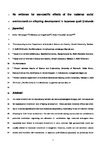No evidence for sex-specific effects of the maternal social environment on offspring development in Japanese quail (Coturnix japonica)
| dc.contributor.author | Langen, E | |
| dc.contributor.author | von Engelhardt, NB | |
| dc.contributor.author | Goerlich-Jansson, V | |
| dc.date.accessioned | 2018-04-13T07:22:44Z | |
| dc.date.issued | 2018-07-01 | |
| dc.identifier.issn | 0016-6480 | |
| dc.identifier.issn | 1095-6840 | |
| dc.identifier.uri | http://hdl.handle.net/10026.1/11269 | |
| dc.description.abstract |
The social environment of reproducing females can cause physiological changes, with consequences for reproductive investment and offspring development. These prenatal maternal effects are often found to be sex-specific and may have evolved as adaptations, maximizing fitness of male and female offspring for their future environment. Female hormone levels during reproduction are considered a potential mechanism regulating sex allocation in vertebrates: high maternal androgens have repeatedly been linked to increased investment in sons, whereas high glucocorticoid levels are usually related to increased investment in daughters. However, results are not consistent across studies and therefore still inconclusive. In Japanese quail (Coturnix japonica), we previously found that pair-housed females had higher plasma androgen levels and tended to have higher plasma corticosterone levels than group-housed females. In the current study we investigate whether these differences in maternal social environment and physiology affect offspring sex allocation and physiology. Counter to our expectations, we find no effects of the maternal social environment on offspring sex ratio, sex-specific mortality, growth, circulating androgen or corticosterone levels. Also, maternal corticosterone or androgen levels do not correlate with offspring sex ratio or mortality. The social environment during reproduction therefore does not necessarily modify sex allocation and offspring physiology, even if it causes differences in maternal physiology. We propose that maternal effects of the social environment strongly depend upon the type of social stimuli and the timing of changes in the social environment and hormones with respect to the reproductive cycle and meiosis. | |
| dc.format.extent | 12-20 | |
| dc.format.medium | Print-Electronic | |
| dc.language | en | |
| dc.language.iso | en | |
| dc.publisher | Elsevier | |
| dc.subject | Fetal programming | |
| dc.subject | Steroids | |
| dc.subject | Development | |
| dc.subject | Mortality | |
| dc.subject | Stress response | |
| dc.subject | Sex allocation | |
| dc.title | No evidence for sex-specific effects of the maternal social environment on offspring development in Japanese quail (Coturnix japonica) | |
| dc.type | journal-article | |
| dc.type | Article | |
| plymouth.author-url | https://www.ncbi.nlm.nih.gov/pubmed/29684400 | |
| plymouth.volume | 263 | |
| plymouth.publication-status | Published | |
| plymouth.journal | General and Comparative Endocrinology | |
| dc.identifier.doi | 10.1016/j.ygcen.2018.04.015 | |
| plymouth.organisational-group | /Plymouth | |
| plymouth.organisational-group | /Plymouth/Faculty of Science and Engineering | |
| plymouth.organisational-group | /Plymouth/Faculty of Science and Engineering/School of Biological and Marine Sciences | |
| plymouth.organisational-group | /Plymouth/REF 2021 Researchers by UoA | |
| plymouth.organisational-group | /Plymouth/REF 2021 Researchers by UoA/UoA04 Psychology, Psychiatry and Neuroscience | |
| plymouth.organisational-group | /Plymouth/Users by role | |
| plymouth.organisational-group | /Plymouth/Users by role/Academics | |
| dc.publisher.place | United States | |
| dcterms.dateAccepted | 2018-04-12 | |
| dc.rights.embargodate | 2019-4-22 | |
| dc.identifier.eissn | 1095-6840 | |
| dc.rights.embargoperiod | No embargo | |
| rioxxterms.funder | Volkswagen Foundation | |
| rioxxterms.identifier.project | Evolution of transgenerational effects: function & genetics of epigenetics. | |
| rioxxterms.versionofrecord | 10.1016/j.ygcen.2018.04.015 | |
| rioxxterms.licenseref.uri | http://www.rioxx.net/licenses/all-rights-reserved | |
| rioxxterms.licenseref.startdate | 2018-07-01 | |
| rioxxterms.type | Journal Article/Review | |
| plymouth.funder | Evolution of transgenerational effects: function & genetics of epigenetics.::Volkswagen Foundation |


